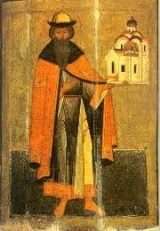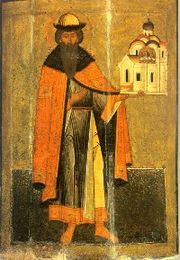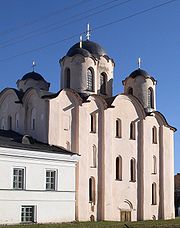
Vsevolod of Pskov
Encyclopedia

Pskov
Pskov is an ancient city and the administrative center of Pskov Oblast, Russia, located in the northwest of Russia about east from the Estonian border, on the Velikaya River. Population: -Early history:...
, ruled as Prince of Novgorod in 1117–32, Prince of Pereslavl (1132) and Prince of Pskov
Pskov
Pskov is an ancient city and the administrative center of Pskov Oblast, Russia, located in the northwest of Russia about east from the Estonian border, on the Velikaya River. Population: -Early history:...
in 1137–38.
Early life
The eldest son of Mstislav the Great and Christina Ingesdotter of SwedenChristina Ingesdotter of Sweden
Princess Christina Ingesdotter of Sweden was a Swedish princess and, by marriage, a princess of Veliky Novgorod, Rostov and Belgorod, spouse of Grand Prince Mstislav I of Kiev....
, Vsevolod was born in Novgorod during his father's reign as prince there (1088–1093, 1095–1117) and given the baptismal name Gabriel, or Gavriil. His maternal grandfather was King Inge the Elder of Sweden
Sweden
Sweden , officially the Kingdom of Sweden , is a Nordic country on the Scandinavian Peninsula in Northern Europe. Sweden borders with Norway and Finland and is connected to Denmark by a bridge-tunnel across the Öresund....
. The date of his birth is unknown, although the idea has been advanced that the event was commemorated by the Annunciation Church in the Marketplace, founded by Mstislav in 1103.
He was enthroned as Prince of Novgorod after his father Mstislav Vladimirovich became Grand Prince of Kiev
Kievan Rus'
Kievan Rus was a medieval polity in Eastern Europe, from the late 9th to the mid 13th century, when it disintegrated under the pressure of the Mongol invasion of 1237–1240....
in 1117 and ruled Novgorod, with some interruption, until he was ousted by the Novgorodians in 1136. He was married to a Chernigovian princess in Novgorod in 1123 and his son, Ivan, was born there (he died in 1128). In 1123, Vsevolod led the Novgorodians against the Chud
Estonians
Estonians are a Finnic people closely related to the Finns and inhabiting, primarily, the country of Estonia. They speak a Finnic language known as Estonian...
. These campaigns continued in 1130 and over the next several years. Aside from Vladimir Yaroslavich
Vladimir of Novgorod
Vladimir Yaroslavich reigned as prince of Novgorod from 1036 until his death. He was the eldest son of Yaroslav I the Wise of Kiev by Ingigerd, daughter of king Olof Skötkonung of Sweden....
, Vsevolod was the first Novgorodian prince known to have been in conflict with Finns
Finnish-Novgorodian wars
The Finnish–Novgorodian wars were a series of conflicts that took place between Finnic tribes in eastern Fennoscandia called "Yem", and the Republic of Novgorod from the 11th or 12th century to early 13th century. The wars seem to have contributed to the eventual Swedish conquest of Finland in...
(in 1123).
Expulsion from Novgorod
Following his father's death in 1132, support for him began to erode in Novgorod. That same year, he was sent by his uncle, Grand Prince YaropolkYaropolk II of Kiev
Yaropolk II Vladimirovich , Prince of Pereyaslav , Velikiy Kniaz of Kiev , son of Vladimir II Monomakh and Gytha of Wessex. He fought in several campaigns against the Polovtsy , once in 1103 and again in 1116.After the death of his brother in 1132, Msitslav I the Great, Yaropolk received the...
, to Pereslavl, to reign there. When he tried to return to Novgorod later that year, the Novgorodians refused to accept him back because they considered his move to Pereslavl as a betrayal (He had sworn an oath to die in Novgorod). That being said, the chronicles indicate that he was back leading a Novgorodian army in 1133. It was during that campaign that Vsevolod captured the city of Yuryev (modern Tartu
Tartu
Tartu is the second largest city of Estonia. In contrast to Estonia's political and financial capital Tallinn, Tartu is often considered the intellectual and cultural hub, especially since it is home to Estonia's oldest and most renowned university. Situated 186 km southeast of Tallinn, the...
, Estonia).
In 1134, Vsevolod led an unsuccessful campaign in Vladimir-Suzdal
Vladimir-Suzdal
The Vladimir-Suzdal Principality or Vladimir-Suzdal Rus’ was one of the major principalities which succeeded Kievan Rus' in the late 12th century and lasted until the late 14th century. For a long time the Principality was a vassal of the Mongolian Golden Horde...
during which, according to the Novgorodians, he showed indecisiveness, one of the reasons for his dismissal a little over a year later. On 28 May, 1136, he was confined in the Archbishop's courtyard (compound) in the Detinets along with his wife and family, guarded by thirty men so as not to escape. In mid-July he was allowed to leave, going to his uncle in Kiev. The following year, he tried to come back to Novgorod at the head of an army but withdrew instead to Pskov
Pskov
Pskov is an ancient city and the administrative center of Pskov Oblast, Russia, located in the northwest of Russia about east from the Estonian border, on the Velikaya River. Population: -Early history:...
, where he died in February 1138. According to his own wishes, he was buried in the Church of St. Demetrius in Pskov.
Vsevolod's dismissal from Novgorod has traditionally been seen as the end of Kievan power in the north and the beginning of the Republic of Novgorod. After him a number of princes were invited in or dismissed over the next two centuries, although only a few, like Aleksandr Nevsky, could assert themselves in the city for a prolonged period.
Church-building and veneration

Yuriev Monastery
The St. George's Monastery is one of Russia's oldest monasteries. It stands south of Novgorod on the left bank of the Volkhov River near where it flows out of Lake Ilmen. The monastery used to be the most important in the medieval Novgorod Republic...
. It was Vsevolod who granted the charter to Ivan's Hundred
Ivan's Hundred
Ivan’s Hundred was the first Russian guild, which existed in the 12th-15th centuries in Novgorod.Ivan’s Hundred was an association of merchants, who gathered around the Church of Ivan the Forerunner in Novgorod. The guild consisted of merchants, who traded wax wholesale...
, the first Russian merchant guild
Guild
A guild is an association of craftsmen in a particular trade. The earliest types of guild were formed as confraternities of workers. They were organized in a manner something between a trade union, a cartel, and a secret society...
. In addition, the Cathedral of St. Nicholas in Yaroslav's Court
Yaroslav's Court
Yaroslav's Court was the princely compound in the city of Novgorod the Great. Today it is roughly the area around the Trade Mart, the Church of St. Nicholas, the Church of St. Procopius, and the Church of the Myrrh-bearing Women. The Trade Mart renovated and heavily modified in the sixteenth and...
, while often attributed to his father Mstislav, was mostly built during Vsevolod's tenure in Novgorod.
Vsevolod's comparatively early death prevented him from claiming the Kievan throne. He was survived by a daughter, Wierzchosława, the wife of Bolesław IV the Curly. The prince was canonized by the Russian Orthodox Church
Russian Orthodox Church
The Russian Orthodox Church or, alternatively, the Moscow Patriarchate The ROC is often said to be the largest of the Eastern Orthodox churches in the world; including all the autocephalous churches under its umbrella, its adherents number over 150 million worldwide—about half of the 300 million...
as Vsevolod-Gavriil. In the Stepennaya Kniga (the "Book of Degrees of Royal Genealogy"), he is listed as a Pskov Wonderworker. His relics were moved from the Church of St. Demetrius to the Trinity Cathedral in the Pskov Kremlin in 1193. The Pskovians attached his name to a German sword with the inscription honorem meum nemini dabo, formerly preserved in the cathedral sacristy, but modern historians date the sword to the 15th century at the earliest.
Marriage and children
Married in 1123 in Novgorod to a Chernigovian princess being an uname daughter of Svjatoslav Davidovich- Ivan (died 1128)
- Wierzchosława Wsewolodna(±1124 – 14 march ±1158), Married in 1137 Bolesław IV the Curly, High Duke of Poland
Succession
External links
- Chronology of Novgorod's Political History by the University of Washington

